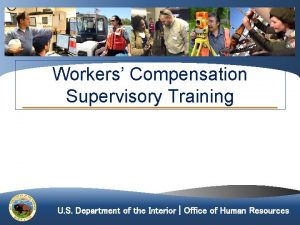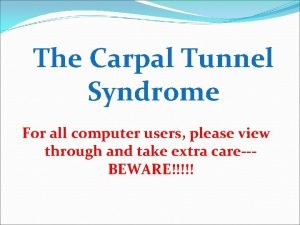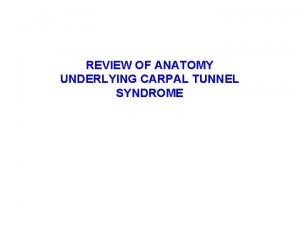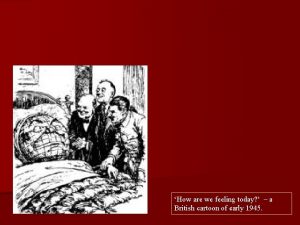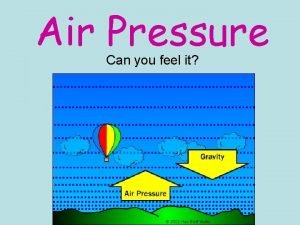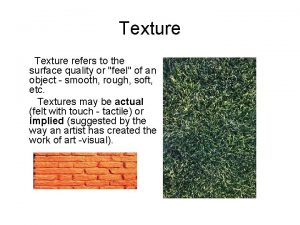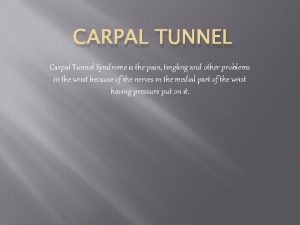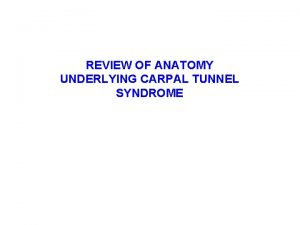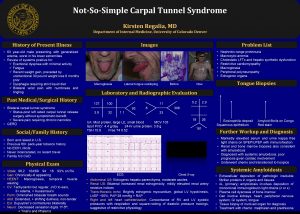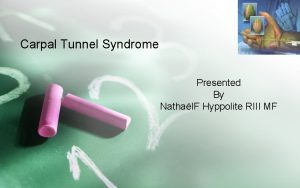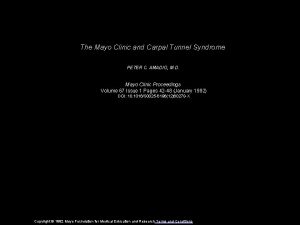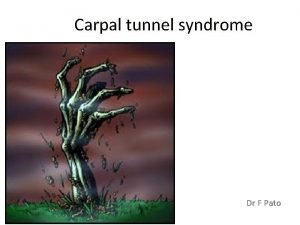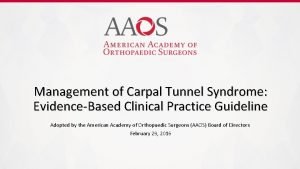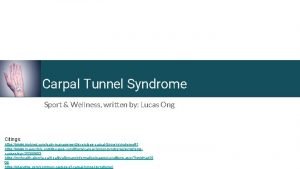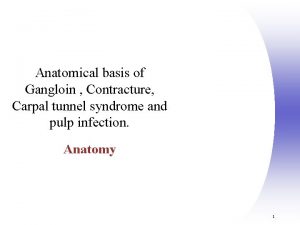CARPAL TUNNEL SYNDROME Do you often feel a























- Slides: 23

CARPAL TUNNEL SYNDROME

ØDo you often feel a numbness or tingling in your hand… especially at night? ØMaybe you experience clumsiness in handling objects and sometimes you feel a pain that goes up the arm to as high as the shoulder. These may be the symptoms of carpal tunnel syndrome Let’s learn more about this common health problem

WHAT IS CARPAL TUNNEL SYNDROME ? Carpal tunnel syndrome is a condition affecting the hand wrist

CARPAL TUNNEL SYNDROME (CTS) CTS involves swelling of the tendons located inside the tunnel space, resulting in pressure on the median nerve

CARPAL TUNNEL SYNDROME The median nerve travels from the forearm into your hand through a “tunnel” in your wrist.

Pressure on the median nerve can result in: sensations of numbness, tingling, pain and clumsiness of the hand. THE COMBINATION OF THESE SYMPTOMS IS CALLED CARPAL TUNNEL SYNDROME

HOW DOES CARPAL TUNNEL SYNDROME DEVELOP? The tendons of the hands are wrapped with a lining that produce a slippery fluid (synovium) which in turn, lubricates the tendons With repetitive movement of the hand, the lubrication system may malfunction This reduction in lubrication results in inflammation and swelling of the tendon area Repeated episodes of swelling cause thick tissue to form and prevents tendon movement

HOW COMMON A PROBLEM IS CARPAL TUNNEL SYNDROME? The dominant hand is usually affected first and produces the most severe pain. Women are three times more likely than men to develop carpal tunnel syndrome, perhaps because the carpal tunnel itself may be smaller in women than in men. Especially common in those performing assembly line work - manufacturing, sewing, finishing, cleaning, and meat, poultry, or fish packing. CTS is three times more common among assemblers than among data-entry personnel A recent survey of 400 American hand surgeons reported that each surgeon performs over 65 operations for carpal tunnel syndrome every year

WHAT CAUSES IT? THERE ARE TWO BASIC CATEGORIES OF CAUSES Work Related Causes Repetitive Task Profession Grabbing & tugging cloth Tailor, sewer Handling objects on conveyor belt Assembly-line worker Hand weeding Gardener Using spray gun Painter Knitting Homemaker Turning keys Locksmith Typing Clerical worker Using scanner at checkout counter Cashier Scrubbing Janitor Stringed instruments Musician

Non-Work Related Causes Arthritis Diabetes Thyroid gland imbalance Gout Broken or dislocated bones of the wrist Wrist cysts * Most cases have no known cause

WHAT ARE THE SYMPTOMS OF CARPAL TUNNEL SYNDROME? Tingling of the thumb, index, middle & ring fingers. Especially at night & after using hands Relieved by shaking, hanging or massaging your hands Dropping objects, inability to keep or count change with the affected hand

HOW IS IT DIAGNOSED? Tinel’s Test: Doctor taps the median nerve at the wrist producing a tingling feeling…like hitting your funny bone)

Phalen’s Test: Symptoms can be reproduced when wrists are kept down in a bent position for one minute

ELECTROMYOGRAPHY “THE GOLDEN STANDARD” Electrodes are placed on the forearm and a mild electrical current is passed through the arm. Measurement of how fast & how well the median nerve responds indicates if there is damage to the nerve.

TREATMENT OPTIONS? Mild Cases: Splint (usually worn at night) to prevent the wrist from bending. Relieves swelling through rest. Medications: Oral antiinflammatories. The swollen membranes are reduced

TREATMENT FOR SEVERE CASES Cortisone injection: Medication surrounds the swollen membranes & tendons… shrinking them (effective when diagnosis is made early) Surgery: under local anesthetic. Relieves pressure on the median nerve. Usually considered day surgery.

OPEN CARPAL TUNNEL RELEASE The surgeon makes a 2 -5 inch incision in the lower palm and wrist area. The carpal ligament is opened. This frees the median nerve. The incision is closed with stitches. A bulky bandage is applied to the wound, with care taken to ensure that finger movement is NOT restricted.

ENDOSCOPIC CARPAL TUNNEL RELEASE A tiny, ½-inch incision is made on the palm side of the wrist. A miniature fiber optic camera is passed through. This camera allows the surgeon to view the inside of the carpal tunnel. Another tiny incision is made. Surgical tools are passed in. While looking at the monitor, these instruments are used to release the carpal ligament and free the median nerve. After the camera and instruments are removed, a few stitches are necessary to close the incisions. A bulky bandage is placed over the wounds.

WHAT CAN I EXPECT AFTER THE SURGERY? Tenderness at incision site until healing complete Symptom relief immediately or shortly afterwards Numbness may remain for a period of time in older individuals or more severe cases

EXERCISES Post Surgery Physical activities can be resumed only after a few weeks & for some a few months Exercises will be given in order to build muscle strength, joint flexibility of hand wrist

OUTCOME You may have to wear a brace or splint for several weeks after surgery. Complete recovery may take 4 -6 weeks or longer. The numbness or tingling in your hand fingers usually improves rather quickly. Your grasp strength will very slowly begin to improve.

SURGERY SUCCESS RATE 1 st 2 nd surgery 50 – 60% surgery 35 – 45% Carpal Tunnel Syndrome comes back for over 85% of people within 6 months to 8 years of a successful surgical procedure.

 Carpal tunnel
Carpal tunnel Assistive devices for carpal tunnel syndrome
Assistive devices for carpal tunnel syndrome Cutaneous nerve forearm
Cutaneous nerve forearm Owcp schedule award carpal tunnel
Owcp schedule award carpal tunnel Carpal tunnel release scar
Carpal tunnel release scar Ject throw
Ject throw Art spheroidea
Art spheroidea El parmak sinirleri
El parmak sinirleri Carpal bones
Carpal bones Humero partes
Humero partes How do you feel when you
How do you feel when you Always often sometimes hardly ever never
Always often sometimes hardly ever never Places you can feel your pulse
Places you can feel your pulse Microscope madness vocabulary answer key
Microscope madness vocabulary answer key How do you feel today
How do you feel today How we feeling meaning
How we feeling meaning Metaphor in the song happy
Metaphor in the song happy Did you feel it hawaii
Did you feel it hawaii Can you feel it in the air in the air
Can you feel it in the air in the air Google imagens
Google imagens Feel like a blob
Feel like a blob Do you ever feel already buried deep
Do you ever feel already buried deep Why do you feel proud of mt everest and gautam buddha
Why do you feel proud of mt everest and gautam buddha Texture is the surface quality
Texture is the surface quality



